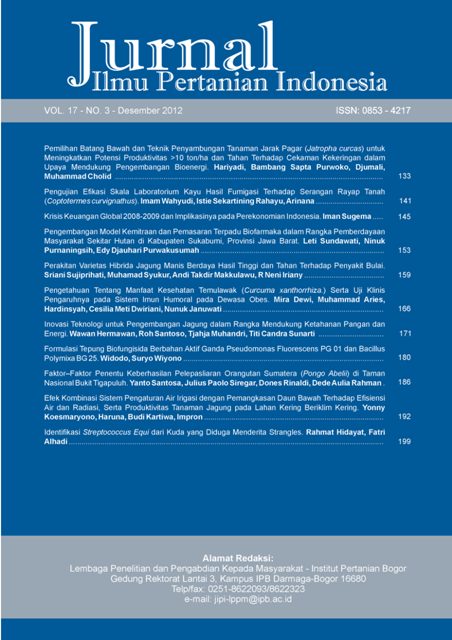Efek Kombinasi Sistem Pengaturan Air Irigasi dengan Pemangkasan Daun Bawah Terhadap Efisiensi Air dan Radiasi, Serta Produktivitas Tanaman Jagung pada Lahan Kering Beriklim Kering
Abstract
Study on the effect of dose management on water irrigation and the effect of pruning corn lower leaves on productivity of Lamuru variety grown on dry land of dry climate area has been done. The experiment was organized at Naibonat Experimental Station, East Kupang Subdistrict, Kupang, East Nusa Tenggara, from June to October 2011. The area used was 72 × 32 m using split plot design methods, employing two treatments. The first treatment was conducted on the main plot with water irrigation dose given 100, 80, and 60% the dose control was according to the farmer’s customary. The second treatment was applied by pruning or not pruning the lower leaves at the generative phase on the determined submain plot. The result showed that dose of water irrigation of 80 and 60% gave significant effect on corn productivity, that is 7.3 and 5.3 ton/ha, but not significant to the control (6.6 ton/ha). On the other hand, the treatment with and without leaf pruning did not give significant effect on the growth component because pruning was conducted during the generative phase. The Anova test result of corn productivity was not significantly different between the treatment of with and without pruning. The treatment of 80% dose of water irrigation could save water until 842 m3 or 20% per planting season per hectare. Meanwhile, the farmer’s customary wasted the water up to 2.105 m3 or 50% per planting season per hectare. Based on the results, the optimizing of water irrigation interval is seven times more efficient in one planting period as compared to 14 irrigation times in one planting period.
Downloads
References
Arora VK, Singh CB, Sidhu AS, Thind SS. 2011. Irrigation, tillage and mulching effects on soybean yield and water productivity in relation to soil texture. J Agric Water Manage. 98: 563-568.
Adimihardja A, Mulyani A, Hikamtullah, Siswanto AB. 2005. Prospek dan Arah Pengembangan Agribisnis: Tinjauan Aspek Kesesuaian Lahan. Jakarta (ID): Badan Litbang Pertanian. 20 hlm.
Bakker M, Meinzen-Dick R, Konradsen. Eds. 1999. Multiple uses of water irrigated areas. A cases study from Srilangka. Colombo: SWIM paper No. 8 1999. IWMI.
Camp VM, Radfara M, Walraevens K. 2010. Assessment of ground water storage depletion by over exploitation using simple indicators in an irrigated closed aquifer basin in Iran. J Agric Water Manage. 97: 1876-1886.
Doorenbos J, Pruitt WO. 1975. Guidelines for predicting crop water requirements. Irrigation and Drainage Paper (FAO), no. 24. Rome (IT): FAO, Land and Water Development Div.
Hidayat A, Mulyani A. 2002. Lahan kering untuk pertanian. Dalam Abdurachman et al. (ed.). Teknologi Pengolahan Lahan Kering menuju Pertanian Produktif dan Ramah Lingkungan. Bogor (ID): Pusat Penelitian Tanah dan Agroklimat hlm. 1-39.
Irianto G, Sosiawan H, Karama AS. 1998. Strategi pembangunan pertanian lahan kering untuk mengantisipasi persaingan global. Pertemuan Pembahasan dan Komunikasi Hasil Penelitian Tanah dan Agroklimat, Bogor 10 Feb 1998. Bogor (ID): Pusat Penelitian Tanah dan Agroklimat, Badan Litbang Pertanian.
Kartiwa B, Sosiawan H, Sumarno, Subagyono K. 2009. Optimalisasi dosis dan interval irigasi tanaman jagung di lahan kering beriklim kering di Sumba Timur. Studi kasus di Desa Kambatatana Kecamatan Pandawai Kabupaten Sumba Timur. Bogor (ID): Balai Penelitian Agroklimat. Badan Litbang Pertanian.
Kedang A, Haruna. 2008. Pengkajian waktu tanam dan pola tanam pada agroekosistem lahan kering dan sawah tadah hujan di NTT. Balai Pengkajian Teknologi Pertanian. Laporan Akhir Tahun 2008. (Tidak dipublikasikan).
Kadekoh. 2003. Efisiensi penggunaan lahan, nilai setara kalori dan protein pada berbagai waktu defoliasi jagung dan jarak tanam kacang tanah dalam sistem tumpangsari pada musim berbeda. J Agrikult. 14: 99-105.
Las I, Makarim AK, Hidayat A, Karama AS, Manwa I. 1991. Peta Agroekologi Utama Tanaman Pangan Indonesia. Bogor (ID): Pusat Penelitian dan Pengembangan Tanaman Pangan. Badan Litbang Pertanian. Bogor. 24 hlm.
Sutono S, Wiganda S, Isyafudin I, Agus F. 2001. Pengelolaan Sumberdaya air dengan teknologi input tinggi. Laporan Akhir Tahun Anggaran 2001. Bagian Proyek Penelitian Sumberdaya Lahan dan Agroklimat dan Proyek Pegkajian Teknologi Pertanian Partisipatif. Pusat Penelitian dan Pengembangan Tanah dan Agroklimat Badan Penelitian dan Pengembangan Pertanian, Departemen Pertanian. (Tidak dipublikasikan).
Soelaeman Y, Anny Mulyani, Irawan, Sutono S, Sudrajat. 2001. Potensi Irigasi Lahan Kering Tingkat Petani: Studi Kasus Kecamatan Terbanggi Besar dan Bangunrejo, Lampung Tengah. Prosiding Seminar Nasional. Pengelolaan Sumber daya Alam untuk Mencapai Produktivitas Optimum Berkelanjutan. Volume II. Bandar Lampung 26-27 Juni 2001. Bandar Lampung (ID): Universitas Lampung.
Tala’ohu SH, Sutono S, Soelaeman Y. 2003. Peningkatan produktivitas lahan kering masam melalui penerapan teknologi konservasi tanah dan air. Hal. 45-63 dalam Prosiding Simposium Nasional Pendayagunaan TanahMasam, Bandar Lampung, 29-30 September 2003. Pusat Penelitian dan Pengembangan Tanah dan Agro-klimat. Badan Penelitian dan Pengembangan Pertanian, Departemen Pertanian. Bogor.
Partowijoyo A. 2002. Penelitian kebutuhan air lahan dan tanaman di beberapa daerah irigasi. J Penel Pengemb Pengair. Vol. 16: No. 49 Desember 2002. ISSN 02-1111. Pusat Penelitian dan Pengembangan Sumber Daya Air. Badan Litbang Permukiman dan Prasarana Wilayah, Departemen Permukiman dan Prasarana Wilayah.
Wu Y, Huang M, Gallichand J. 2011. Transpirational response to water availability for winter wheat as affected by soil textures. J Agric Water Manage. 98: 569-576.
This journal is published under the terms of the Creative Commons Attribution-NonCommercial 4.0 International License. Authors who publish with this journal agree to the following terms: Authors retain copyright and grant the journal right of first publication with the work simultaneously licensed under a Creative Commons Attribution-NonCommercial 4.0 International License. Attribution — You must give appropriate credit, provide a link to the license, and indicate if changes were made. You may do so in any reasonable manner, but not in any way that suggests the licensor endorses you or your use. NonCommercial — You may not use the material for commercial purposes.



















